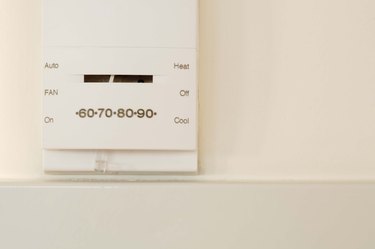Things You'll Need
Screwdriver
Wire stripper
Drywall anchors
Screws
Level
Cordless drill

Forced air furnaces provide the heat we need in our homes during the winter months. Furnaces need a thermostat in order to turn the furnace on and off as needed. Without a thermostat, the furnace would heat the home to uncomfortable temperatures. The kind of heating and cooling system you have will determine how many wires run from your furnace to your thermostat. Heating-only systems use two wires, air conditioning adds two more wires, and if you have a two-stage furnace, you'll need yet one more wire. It is actually fairly easy to install a thermostat to control a forced air furnace.
Step 1
Turn off power to your forced air furnace. This is done by turning off the breaker in the circuit breaker panel.
Video of the Day
Step 2
Open the furnace access panel and look for the control board. The thermostat wire will connect to a terminal strip on it. Make note of what wire connects to what terminal. For a simple home heating and air conditioning system, normally the red wire is on the "R" terminal, the white wire is on the "W" terminal, the yellow wire is on the "Y" terminal, and the green wire is on the "G" terminal.
Step 3
Close the access panel and head to where your existing thermostat is located. If the old thermostat is still there, you'll need to remove it, disconnect the wires, and remove the wall plate.
Step 4
Mount the new thermostat wall plate to the wall using drywall anchors and screws. Level it with your level.
Step 5
Check the thermostat wires to see if they are stripped back to expose 1/4-inch of bare copper. If not, strip them with your wire stripper.
Step 6
Connect each wire to the thermostat in the same fashion that they are connected to the furnace in step 2. Attach the thermostat to the wall plate by gently pushing it on until it snaps into place.
Step 7
Turn the power back on to the furnace and set the thermostat to the temperature you want in the room.
Warning
When you are hooking up the thermostat, the power absolutely needs to be off to the furnace. Failure to do so can result in electric shock to you or damage to the control board inside the furnace.
Video of the Day